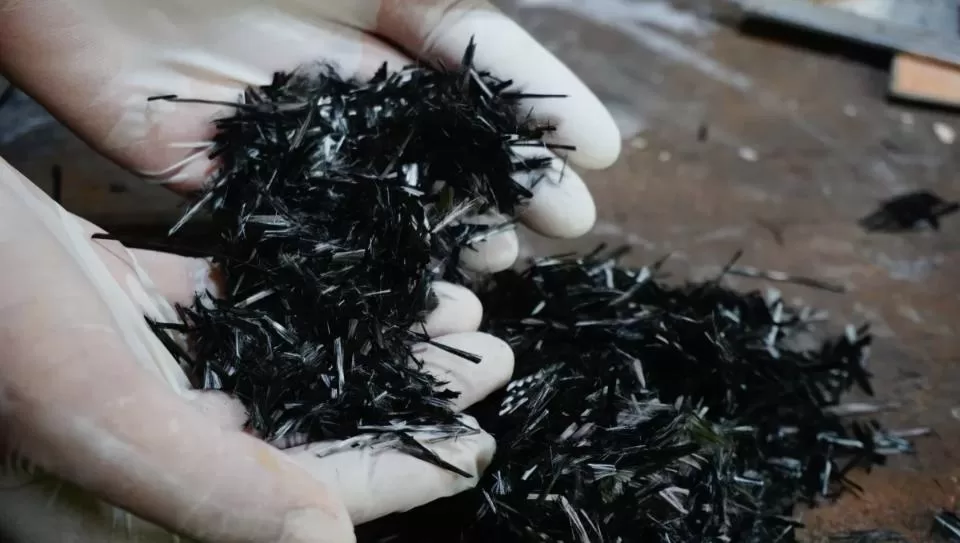
Overview of Carbon Fibre Recycling
Carbon fibre is a strong, lightweight material made from thin, durable fibres of carbon. It is used in a wide range of industries, including aerospace, construction, and automotive, due to its high strength-to-weight ratio, durability, and resistance to corrosion. Carbon fibre is typically produced from petroleum-based precursors like polyacrylonitrile (PAN), which are transformed into carbon fibre through a high-temperature and oxygen-free heating process.
However, despite its many benefits, carbon fibre is not easily recyclable. This is because the process used to produce carbon fibre results in a material that is difficult to break down and recycle. As a result, a large amount of carbon fibre waste is generated at the end of a CFRP product’s lifecycle, which can have negative environmental impacts if not properly disposed of. Recycling carbon fibre helps to reduce waste and conserve resources, and it can also produce recycled materials that are comparable in quality to virgin materials. By promoting carbon fibre recycling, we can help reduce waste and promote sustainability, while still enjoying the benefits of this important material.
The Recycling Process
There are several methods for recycling carbon fibre, including mechanical, chemical, and thermal processes. Mechanical processes involve mechanically breaking down the carbon fibre into small pieces and then using these pieces to produce new products, often by shredding. This method is relatively simple, but it may result in a lower-quality product compared to other methods.
Chemical processes, on the other hand, involve dissolving the resin in chemicals to break it down and retrieve the intact carbon fibres, which can then be used to produce new products. This method is more complex than mechanical processes, but it can produce higher-quality recycled carbon fibre, which retains the majority of the fibre’s original mechanical properties However, the solvent costs for this method can be high, while also producing challenging by-products that have to be dealt with.
Thermal processes, also known as pyrolysis, involve heating the carbon fibre to high temperatures in an oxygen-free environment to break it down into its constituent parts. This method can produce high-quality recycled carbon fibre, but it is also the most energy-intensive and expensive of the three methods. Tests of this method have shown varying results, but it as has been shown to retain almost all the mechanical properties of virgin carbon fibre.
Each of these methods has its own advantages and disadvantages, and the choice of method will depend on factors such as the type of carbon fibre being recycled, the desired end product, and the cost of the process. The development of new and more efficient recycling methods will be important for the growth of the carbon fibre recycling industry.
Challenges and Barriers to Adoption
Carbon fibre recycling faces several challenges and barriers to widespread adoption. One major challenge is the lack of a standardized process for recycling carbon fibre. This means that different companies and organizations may use different methods for recycling carbon fibre, which can result in inconsistent quality and difficulties in scaling up the industry. Another challenge is the limited infrastructure for collection and processing of carbon fibre waste. This makes it difficult for recyclers to obtain enough waste material to produce significant quantities of recycled carbon fibre. That said, specific efforts are being made to direct carbon fibre waste to recycling facilities.
Future Prospects and Growth Opportunities
The future prospects for the carbon fibre recycling industry are positive, with several factors likely to drive growth in the coming years. One key driver of growth is increased demand for carbon fibre products, which will result in more waste material that can be recycled. As the use of carbon fibre continues to grow in industries such as aerospace, construction, and automotive, the need for effective recycling solutions will become increasingly important.
Another factor that is likely to drive growth in the carbon fibre recycling industry is technological advancements. As recycling methods and technologies continue to improve, it will become easier and more cost-effective to recycle carbon fibre. This will make it possible to produce high-quality recycled carbon fibre that is comparable to and competitive with virgin materials, which will increase the demand for recycled carbon fibre. In addition, advances in materials science and engineering will also likely lead to new applications for recycled carbon fibre, further expanding the market for recycled materials.
Finally, government support and growing public awareness about the importance of recycling will also play a key role in driving growth in the carbon fibre recycling industry. Governments can provide incentives and funding for research and development in the field, which will help to advance recycling technologies and reduce the barriers to widespread adoption. Meanwhile, as the public becomes more aware of the environmental benefits of recycling, they may also demand that companies use more recycled materials in their products, further increasing the demand for recycled carbon fibre.
Impact on the Environment and Industry
The production and use of carbon fibre has an impact on the environment, particularly in terms of energy consumption and greenhouse gas emissions. Carbon fibre is produced from petrochemicals, which are fossil fuels that require significant energy input to extract and process. The production process also requires high temperatures and energy, which can result in further emissions. However, by recycling carbon fibre, the industry can reduce the demand for virgin materials, which in turn can reduce emissions and energy consumption.
In addition to reducing the environmental impact of carbon fibre production, widespread adoption of carbon fibre recycling can also have numerous benefits for the industry. For example, recycling carbon fibre can reduce the cost of production by using recycled materials instead of virgin materials, which are often more expensive.
This can increase competitiveness in the industry and lead to lower prices for consumers. In addition, recycling carbon fibre can also increase the supply of high-quality recycled materials, which can help to meet the growing demand for carbon fibre products.
Furthermore, carbon fibre recycling can also have a positive impact on the environment by reducing waste. Carbon fibre waste is non-biodegradable and so will likely remain in landfill for an exceedingly long time without breaking down. By recycling carbon fibre, the industry can reduce the amount of waste that ends up in landfills and the environment, which can have a positive impact on the environment and local communities by minimising the need to expand landfill sites across the globe. Overall, widespread adoption of carbon fibre recycling can have numerous benefits for both the environment and the industry.

